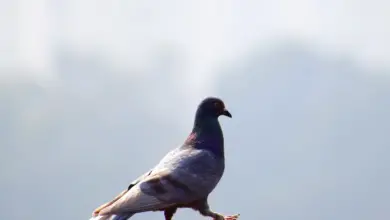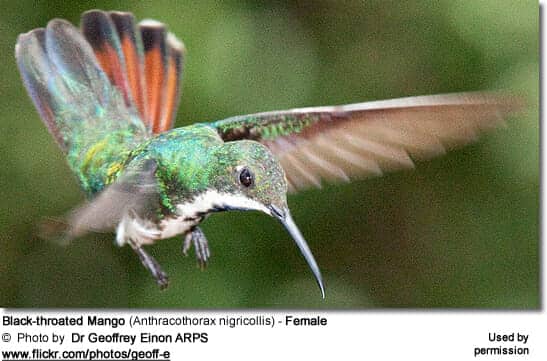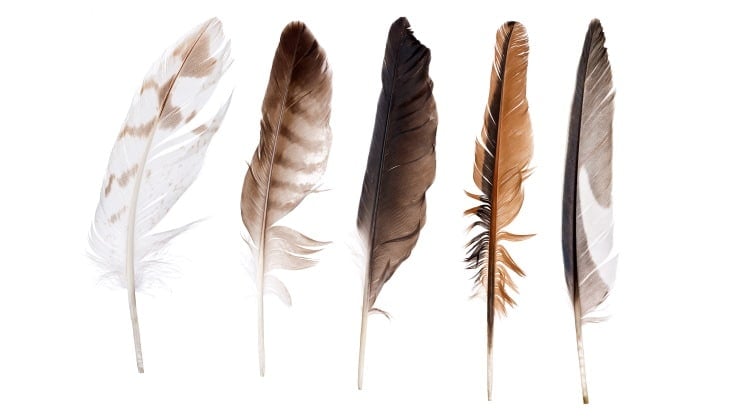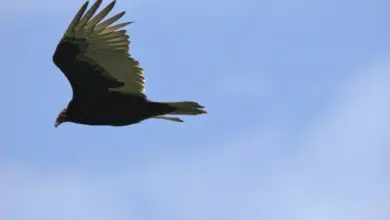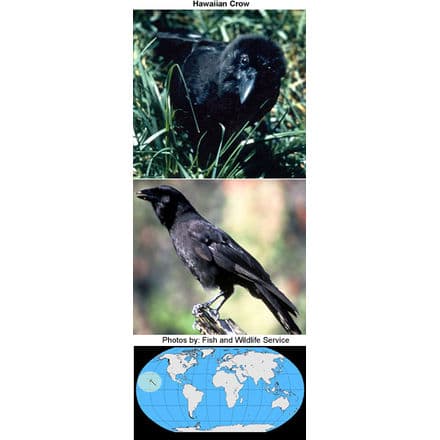Domesticated Muscovy Ducks
Domesticated Muscovy Ducks: Species Details & What You Should Know
This article will be an extensive guide to all things Muscovy ducks. A duck bible, if you will.
From learning how to sex your muscovy to finding out what their favorite food is, there really is no stone left unturned.
Read on to discover the fascinating lives of Muscovy ducks.
Interesting Facts About Muscovy Ducks
But first, the facts.
There’s no point in learning how to care for a Muscovy if you don’t fully understand them. So, let’s start off with some interesting facts about Muscovy ducks.
- Muscovy ducks roost in trees. Despite being a species of waterfowl, Muscovies tend to make nests in tree cavities up to 60 feet off the ground.
- They have sharp claws on the back of their webbed feet to help them perch in branches.
- They do not quack. Instead, they communicate through tail wagging and hissing.
- They originate from the forests of South America and extend their range into Central and North America.
- They have been domesticated for thousands of years – probably way before European settlers first ventured to the American continent.
- They have bright red faces!
Muscovy Ducks: Key Physical Characteristics
How Long Do Muscovies Live?
Muscovy ducks have one of the longest lifespans of any duck species. Most Muscovies in captivity typically live on average for 12 years.
However, with the right care, such as a varied diet, plenty of space, and clean sources of water, a domestic Muscovy duck may live to reach 20 years of age.
Wild ducks, on the other hand, have a reduced life expectancy of around 6 – 8 years. This is due to predation rates, as well as other natural causes, such as disease.
Where do Muscovy Ducks Live? Their Habitats
Muscovy ducks are native to Central and South America. In their native range, they tend to stick close to heavily vegetated waterways, forests, or swamps.
However, populations of domesticated Muscovies have escaped captivity and become wild birds with flocks of their own across the world. These are referred to as feral ducks.
These feral ducks are hardy and can be found in an array of environment types, including urban parks and golf courses.
Male & Female Muscovies: Physical Differences And How To Sex Them
Male and female muscovy ducks look relatively similar.
However, look closer, and small yet distinct features stand out, which will allow you to differentiate between the two sexes.
One of the biggest differences is the size. Males can weigh up to 15 lbs and measure lengths of 31 inches.

This is almost double the size of females, who, on average, weigh no more than 7 lbs and measure just over 23 inches.
Besides their size, the patch of red skin around their face, known as the caruncle, is another great way of sexing your Muscovy ducks.
A male will develop the caruncle at an earlier age, at around 15 weeks of age. It spreads across much of the head.
A female will not start developing her caruncle until about 20 weeks of age. It remains closed around the eyes and the base of the beak.
What Colors Are Muscovies?
Muscovy ducks display a range of color schemes.
One of the most common color varieties found in Muscovies is black.
This is because the wild ancestors of Muscovies display this color pattern, perhaps as a way to blend into the gloom of the forest.
They are dark with glossy green feathers and white wing tips.
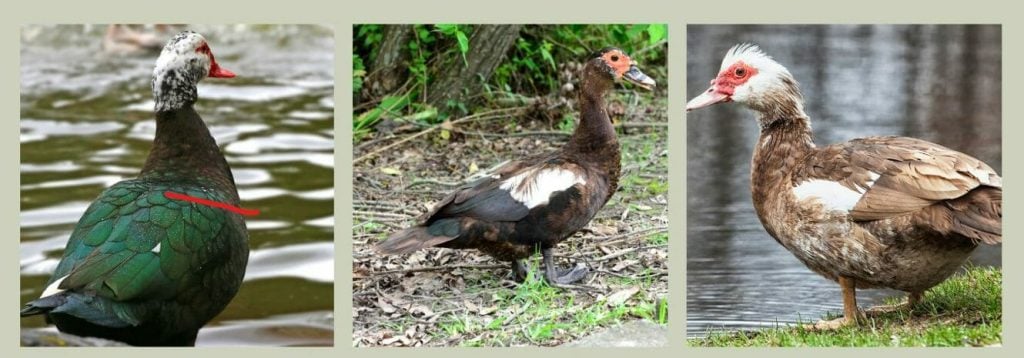
Other common color patterns include white and pied.
Certain genes that act upon coloration are selected and actively bred through feather generations to result in different-colored Muscovies.
Other color variations include lavender, chocolate, sepia, brown, and magpie.
Why Do Muscovy Ducks Have Red Faces?
The red faces of a Muscovy duck are a unique characteristic of this waterfowl species.
Known as the caruncle, this red, wart-like skin serves a variety of important functions.
Firstly, the caruncle contains oil glands which Muscovies use to waterproof their feathers.
The caruncle is also used as a way of displaying the overall health of the bird.
For example, males with a larger, darker caruncle have higher levels of testosterone, which in turn, often results in stronger and fitter individuals.
What Do Muscovy Ducks Eat?
Muscovy ducks are omnivorous, consuming a wide variety of different food groups. Their diet consists of both animal and plant protein.
One of the favorite items on the Muscovy menu is insect larvae, especially mosquitoes.
Invertebrates, such as insects and crustaceans, as well as small vertebrates, such as fish, also feature heavily in the diet of Muscovy ducks.

You can find Muscovies foraging around river banks and shallow lakes, often flipping over stones or diving into the water with just their tail exposed.
For domesticated Muscovies, you should consider allowing them time to forage for themselves.
They will keep nasty pest species in check, as well as do all the garden weeding for you.
You can also supplement their diet with grains, seeds, and chicken feed for added nutrients.
Where Do Muscovy Ducks Sleep?
In the wild, you would most likely find Muscovy ducks sleeping in tree cavities. This is an anti-predatory behavior.
Domesticated Muscovies are less picky when it comes to where they sleep.
You may find your Muscovy sleeping on the floor close to a water source. You may find them trying to sleep whilst perching on branches.
It is advisable to add a variety of different-sized branches, at different levels, throughout the run or coop to give your Muscovies sleeping options.
Nesting females will sleep on their clutch of eggs within their nest box. For 35 days, she will only leave her eggs to feed, drink and defecate.
Can Muscovy Ducks Fly?
Wild Muscovy ducks are very capable fliers. After all, it is the only duck that roosts in trees! Females can fly at speeds of up to 80mph!
Domesticated Muscovies, on the other hand, are bulkier, and their flying abilities are compromised.
However, do not let this fool you. If a domestic Muscovy is unhappy, it will not hesitate to fly away. This could be to find more food, fresh water or a mate.
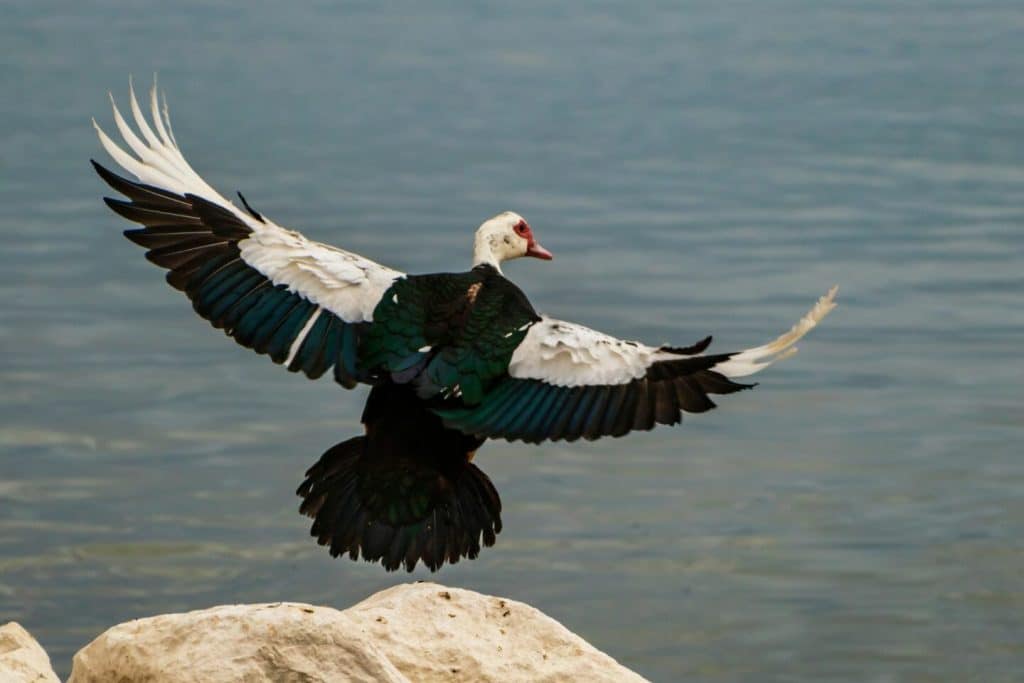
To avoid your Muscovies from flying away, you should, first and foremost, ensure they have a varied diet, plenty of space, clean water, and nest boxes.
However, you can also clip their wings as a precautionary measure. This does not harm your Muscovies.
How Do Muscovy Ducks Survive Winter?
Despite originating from the tropical climates of Central and South America, Muscovy ducks have evolved to adapt to a variety of weather conditions.
This, in part, is due to the widespread domestication of Muscovies.
Some regions, such as Upstate New York, can reach temperatures as low as 10 degrees Fahrenheit (-12 degrees celsius).
While Muscovy ducks can withstand these frigid temperatures, it is not advisable to keep them outside for long durations, as they could develop serious health conditions, such as frostbite.
To help Muscovy ducks survive winter, provide a coop or run with an area indoors. Add plenty of bedding, such as hay or sawdust, for added insulation.
Differences Between Muscovy Ducks and Other Duck Species
Muscovy and Pekin ducks are two of the most common domesticated duck species in the world. However, there are distinct differences between the two duck varieties.
Pekin ducks are white all over with yellow bills. Muscovy ducks can have a variety of color patterns, from dark to lilac to silver.

One of the most distinguishable characteristics of the Muscovy duck is its caruncle. This is a unique feature in waterfowl species – only Muscovies are known to have them.
Muscovies also have a small mohawk of feathers on the crown of its head. Both male and female muscovies have this feather mohawk, but it is more pronounced in males.
A behavioral difference between Muscovy ducks and other species is the amount of time Muscovies spend in the water.
Muscovy ducks also referred to as perching ducks, spend a lot of time in trees, whereas other species of duck spend most of their time in the water.
Muscovy Duck Mating, Nesting & Egg Laying
Unlike other bird species, many of which partner for life, Muscovy ducks are polygynous. This means they do not mate for life.
Over the course of their lifetime, Muscovy ducks may have as many as 15 different partners.
However, Muscovy ducks exhibit seasonal monogamy. This means they form stable pairs for the season to raise a clutch of eggs.
Although male Muscovies will offer no assistance with the raising of offspring, they will stay close to the female and aid with protection.
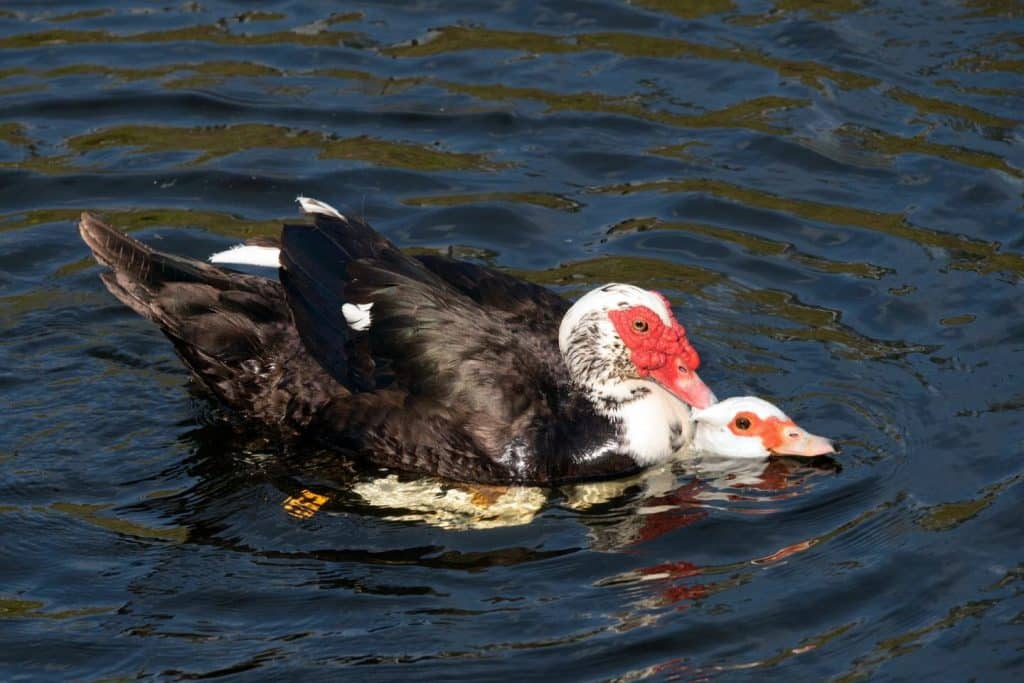
Within the Muscovy world, unwanted sex is a big problem. Males force themselves and try to mate with females.
However, due to some evolutionary advantages, females avoid unwanted pregnancies.
Such adaptations include a vaginal tract that has evolved twists, turns, and dead-ends to prevent any unwanted sperm from fertilizing their eggs.
Where Do Muscovies Nest?
Wild Muscovy ducks nest in tree cavities up in the forest canopy. This is to minimize the predation risk.
Although domesticated Muscovy ducks do not need trees to nest in, there are certain requirements that they need, the most important being nest boxes.
Nest boxes are small, often raised, areas where a female can come to lay her eggs. They should be enclosed and provide a feeling of security and comfort.
If possible, you should slightly raise the nest boxes off the ground. This mimics a wild setting and prevents accidental breakage from wandering adults.
You should fill the inside with a layer of dust-free sawdust for additional comfort and insulation.
Egg Laying & Incubation In Muscovies
After discussing mating and nesting, can egg laying be far behind?
Muscovy ducks typically lay a clutch of between 12-16 eggs. However, some females can lay up to 20 at a time!
Unlike other species of waterfowl or poultry, which typically staggers the laying process, a muscovy duck lays a clutch of eggs at the same time.
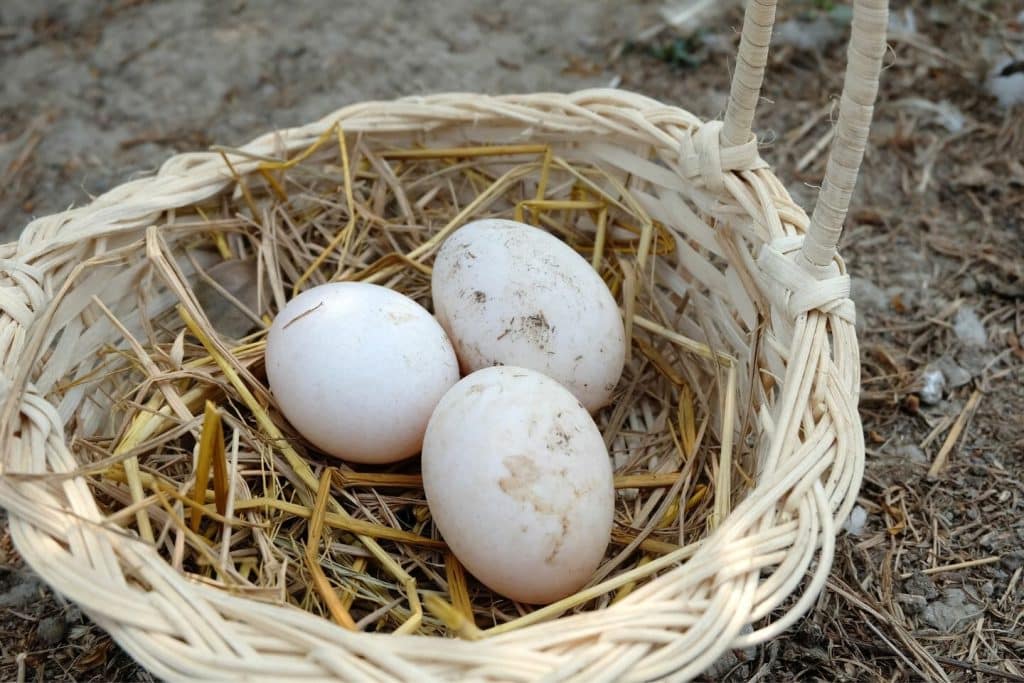
The female will sit on her clutch of eggs for up to 35 days, an entire week longer than chickens and other species of ducks.
She will only leave her brood to eat, drink and defecate.
To hatch successfully, incubation needs to be around 35.7 – 38.8 degrees celsius.
This can also be done via artificial incubation, whereby eggs are placed in an incubator, and environmental factors, such as temperature and humidity, are closely controlled.
Muscovy Ducks as Pets: All You Need To Know
Muscovy ducks make great pets.
Firstly, they are quiet. Muscovies cannot quack.
Instead, they hiss and wag their tail to communicate and express feelings of excitement or frustration.
Secondly, compared to other duck species, Muscovies are relatively clean. They do not defecate where they eat or by their eggs.
However, they may make a mess in their water. This is why it should be cleaned regularly.
They are also quite a hardy species that can tolerate temperature extremes. Not that they should be left out in freezing weather!
Lastly, they make great (and free) pest control.
If allowed to roam free-range, domesticated Muscovies will clear patches of annoying and often dangerous pests, such as mosquitoes and ticks.
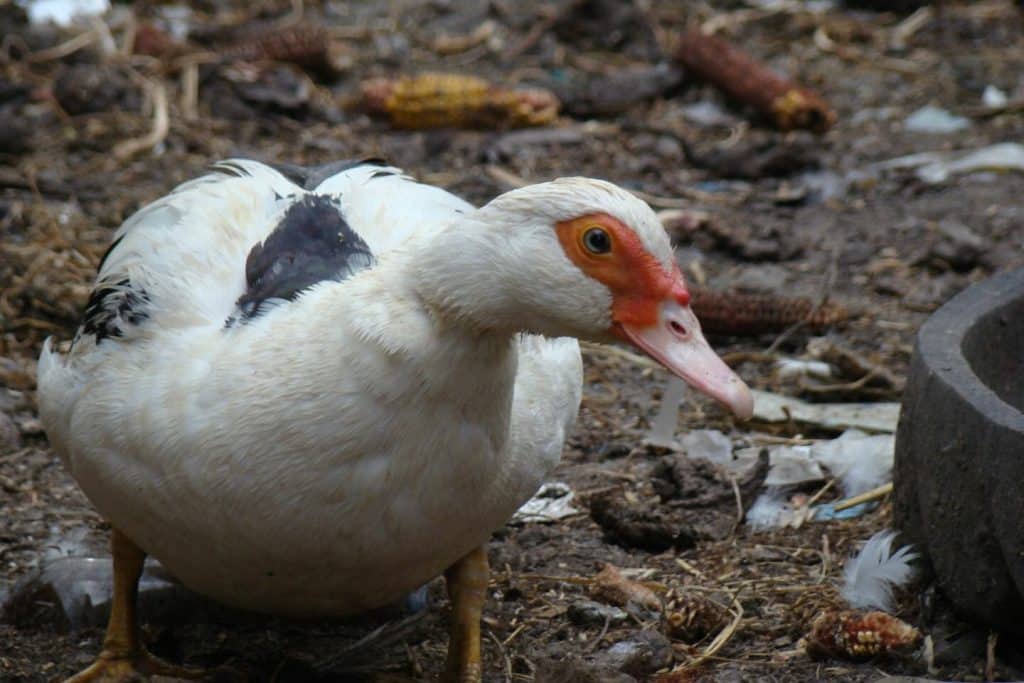
What Are Muscovy Ducks Like?
Muscovy ducks make great pets.
In fact, they can almost show similar behaviors to dogs. Almost…
For one, they express their emotion through a wagging tail. Oftentimes, wagging when they are excited to see you.
They are inquisitive animals and will stay close to their primary caregiver.
They are also intelligent.
From a young age, Muscovies can follow simple commands.
Because of this, you can train them to sleep inside during the night.
Muscovy ducks are quite calm and have a nice temperament.
They are also a comparably quiet species of duck, as they do not quack.
Are Muscovy Ducks Aggressive or Friendly?
Muscovy ducks typically have a mild temperament. Due to this, they can make great pets.
However, like all animals, Muscovies have a wild side.
If provoked, they can become aggressive.
This is most prominent in males during the breeding season. Males compete against each other.
Fights often result in serious injury. Males can also become aggressive when trying to mate with a female.
However, females can also become aggressive. This is especially true for broody females.
During this time, it is best to leave your flock alone so as not to cause unnecessary stress.
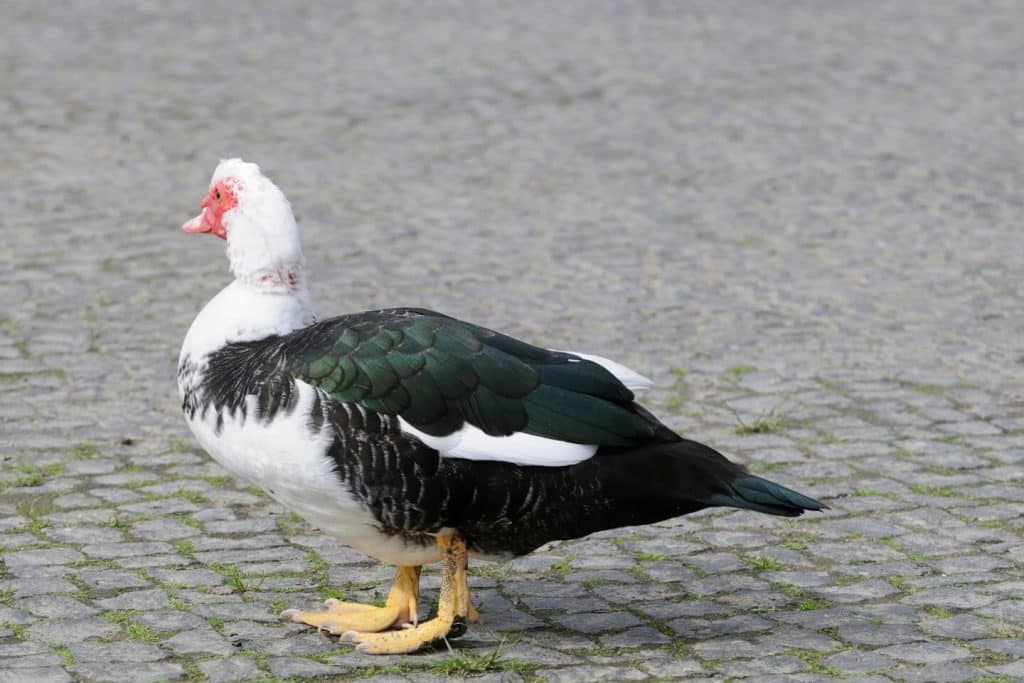
Are Muscovy Ducks Noisy?
Compared to other species of ducks, Muscovy ducks are not noisy.
For starters, they do not quack.
Instead, they communicate with various hiss-like vocalizations.
They also display various ways of communicating physically, such as tail wagging.
Males can be somewhat noisier than females, especially during the breeding season.
So, although they are not completely silent, Muscovy ducks are a relatively quiet species of duck, making them great pets.
Best Housing for Muscovy Ducks?
Although Muscovy ducks are a relatively hardy species, able to withstand a variety of weather conditions, they still need shelter.
If you are worried about predation, you could keep your flock of Muscovies within an enclosed run or coop.
You should allow at least 15 square feet of space per duck.
If you do have a lot of free space, opt for the free-range lifestyle during the day and an enclosed space where your Muscovies can settle down for the night.
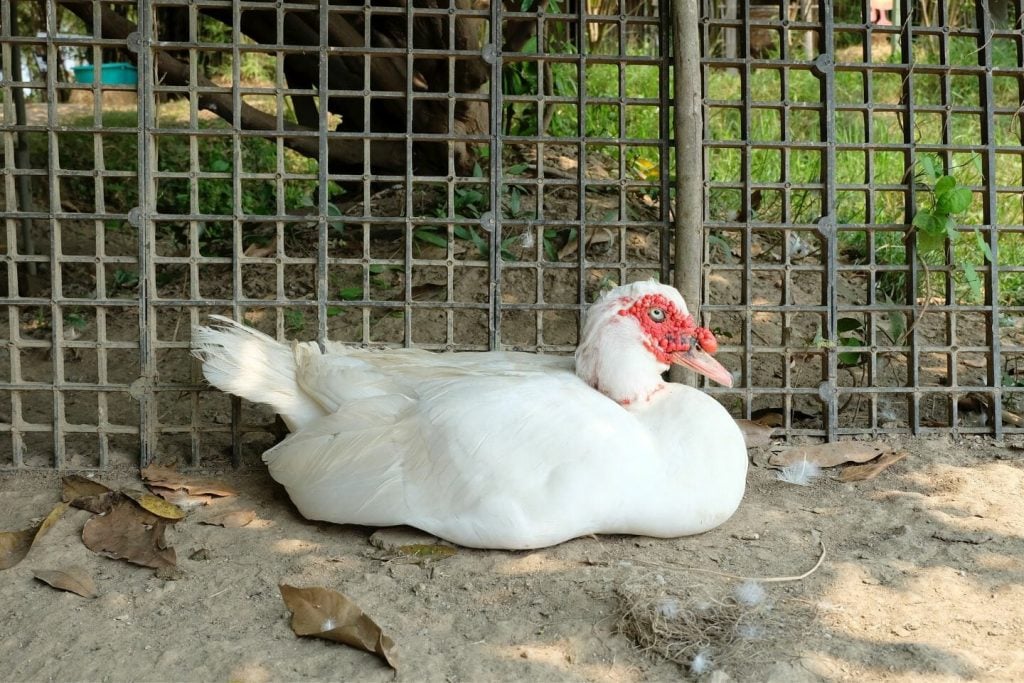
Within this enclosed space, you must include nest boxes. Allow one nest box per duck.
These boxes can be made out of a variety of materials, but wood is the most common.
You need to ensure the nest boxes are covered at all angles (besides an entry hole).
Can You Keep Muscovy Ducks With Chickens & Other Poultry?
You can keep Muscovy ducks with other poultry, such as chickens. However, as with humans, each individual is different.
You should slowly introduce the different species, monitoring their behavior closely.
It is easier to introduce chicks and ducklings together.
However, the mild temperament of Muscovies means it is relatively easy to introduce different species at different stages of their life.
You may find that chickens and broody Muscovies share a nest box together.
This is perfectly normal. In fact, there may be benefits of your Muscovies and chickens sharing the same space, such as added protection.
Can You Eat Muscovy Duck Eggs?
Yes! All across the globe, Muscovy eggs are eaten as a decedent alternative to chicken eggs.
Due to their protein-rich diet, Muscovy eggs provide a healthier option than other egg varieties on the market.
They are high in vitamins and nutrients, such as B vitamins. They are also used in baking to give a fluffier texture.
Do Male Muscovy Ducks Kill Baby Ducks?
Infanticide, or the intentional killing of young offspring, is not uncommon in the animal kingdom.
Muscovy ducks are no exception to this behavior.
Although a relatively rare behavior in Muscovies, males have been known to kill the offspring of a rival male.
This is to induce receptiveness in females, so they can mate again. It could even be to add protein into their diet during times of hardship.
There are certain characteristics you can look out for to try and predict this behavior.
For example, males try to take control over food and drinking water or potential mates.
To avoid a male from killing ducklings, keep the young Muscovies separate from other adults until they are big enough to be introduced.
Also, offer a wide variety of food in different areas to discourage crowding.
Clipping Muscovy Ducks Wings
Muscovy ducks require a lot of care and attention. They need a varied diet, fresh water, plenty of space, and secure places where they can nest.
If they do not feel comfortable in a certain area, Muscovy ducks will fly away.
They are very capable fliers.

If you are worried that your Muscovies may fly away, you can clip the wings of a Muscovy duck.
This is a painless procedure, similar to clipping your own nails.
In fact, the wings are made of the same protein, keratin, as our own fingernails.
A certain level of experience or knowledge is needed to clip the wings of your
Muscovy duck, as, if done wrong, you run the risk of cutting through blood feathers.
This can result in a lot of pain, blood, and even death of your Muscovies.
You should clip ⅓ of the primary feathers. This will have to be done every year after the annual molt.
Wing clipping is a precautionary measure that upsets the balance of the flight.
This means your Muscovies will not be able to fly away.
Muscovy Ducks as an Invasive Species
Muscovy ducks are native to Central and South America. However, they can also be found in small populations around Texas and North America.
Muscovies became domestic ducks and were traded across the globe for hundreds of years.
Many individuals escaped and established self-sufficient populations.
Most populations are small and do not negatively affect the surrounding ecosystem.
However, without predation and other environmental factors keeping numbers under control, some populations can become invasive and negatively affect the environment.
They outcompete native wildlife and are also carriers of certain diseases.
Invasive muscovies are a particular problem in the Southern USA, in states such as Florida.

Are Muscovy Ducks Protected in Florida?
Muscovy ducks are protected in all U.S. states, including Florida, under the federal Migratory Bird Treaty Act.
However, the United States Fish and Wildlife Service has issued warrants to control populations of feral species.
As an individual, you are prohibited from killing any muscovy duck.
If you believe a Muscovy duck is a nuisance or harming the local environment, you can call local wildlife rehabilitators who will relocate the ducks.
Frequently Asked Questions
What type of Muscovy duck is domestic?
Unlike their wild counterparts that inhabit wetlands and forests, domesticated Muscovy ducks are commonly found on farms and homes as backyard poultry.
Their feathers may come in different colors such as black, blue, or chocolate brown; however, they often retain their white wing patches and red-caruncled face.
This unique duck species is popular among breeders due to its adaptability, docile temperament, hardiness, and excellent meat and egg production.
How many types of Muscovy ducks are there?
Technically they are all the same species. However, domesticated Muscovies have been selected for certain characteristics, the most common being feather color.
There are several different color variations and patterns within the breed, such as black, white, and pied.
The Muscovy duck is native to Mexico and Central and South America but has been introduced into other regions for domestication as a food source.
It is a relatively large duck that is often characterized by its distinctive red fleshy growths around its eyes and beak.
What are the characteristics of a domestic Muscovy duck?
They have a distinct appearance with a large red, fleshy caruncle at the base of the bill and a pointed crown on their head.
They come in a variety of colors, including black, white, chocolate, and blue.
Domestic Muscovy ducks are known for being quiet and docile compared to other duck breeds.
They are also good egg layers producing about 120-180 eggs per year on average.
Additionally, these ducks have strong breeding instincts and can hatch their own chicks without assistance from humans.
Can domestic Muscovy ducks fly?
They have been known to fly as high as 60 feet in the air, where they go to perch on tree branches.
Unlike most other ducks, muscovies prefer to roost on trees rather than on the ground.
They even build nests in tree cavities.
Lastly, while muscovy ducks can fly, they don’t have a very long range – only about a mile or so.
If you want to prevent your muscovy duck from flying away, you can clip its wings.
Wrap Up
So, there we have it.
A comprehensive guide to all things Muscovy duck.
There’s no doubt about it. Muscovies are unlike any other species of waterfowl.
Their unique appearance, their quackless voice, and their inquisitive behavior make them a great addition to any home.
There is a wealth of knowledge we are still discovering about these unusual birds. But one thing is for sure, we just can’t get enough of them.
I hope you enjoyed this article and learned a lot about the wonderful world of Muscovy ducks. Thank you for reading.

